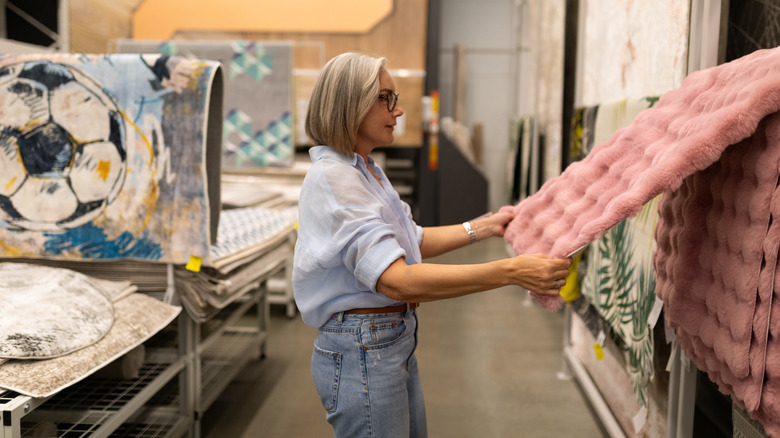How To Tell If You're Overpaying For The Brand Of Your Rug
Shopping for rugs isn't easy. Options range from small and basic to large and luxurious, with the price tags to match. Even if you're a pro and know all the rules for styling rugs, you might still fall for clever marketing and pay a ton of money simply because of a rug's brand, rather than its quality. Brands use fancy lingo to advertise their "artisanal patterns" and luxurious-sounding materials. So, how are you supposed to know if you're overpaying for the brand of a rug rather than its quality?
First things first, if you're looking into getting carpets imported from Iran or Morocco that were hand-woven with fibers like wool, cotton, or silk, you're likely getting a quality rug. Some companies and resellers import these directly, but for that kind of luxury rug, you'll have to pay a hefty price tag. Another option for that type of high-end carpet, but on a lower budget, is to look for vintage ones online and at thrift shops.
If, on the contrary, you're looking for a more contemporary and affordable option, there are still tons of great options out there. But choosing an area rug requires a bit of discernment. Two things to look into are the types of fibers used and how the rugs are being woven. Tons of carpets are made of synthetic fibers and are machine-woven, which are typically more affordable options. But if you're paying a premium price for these, you're likely paying for the brand rather than the quality.
How to know if a synthetic rug is overpriced
As a benchmark, let's look at the price of hand-woven natural-fiber rugs being produced today. Some brands that propose these options have rugs that retail for about $800 for a small, four-by-six-foot area rug. Larger ones, like a nine-by-nine square rug, can cost upwards of $2,000. On average, a synthetic rug of equivalent size should cost 50 percent to 80 percent less.
Because of how cheap synthetic fibers are to produce, there is no reason a synthetic rug should cost nearly as much as a wool one. The way some companies might convince you to spend more on their rugs is because of unique designs and new concepts. For example, a washable rug or a trendy floral pattern. There's nothing wrong with buying trendy carpets, but do keep in mind that if the price and the material don't match up, you're likely paying for the brand and marketing, rather than the quality of the rug.
When choosing a rug for your living room or bedroom, think years ahead. Rugs that are made with natural fibers can last up to 100 years, because you can step on wool over and over again without damaging it. In addition, hand-weaving techniques typically result in tighter and denser carpets, which also helps them last longer. Of course, these expensive carpets also require proper care and cleaning, which is an added cost. Somewhere in the middle, between luxury and marketing scam, you can find some great synthetic rugs that are budget-friendly.

